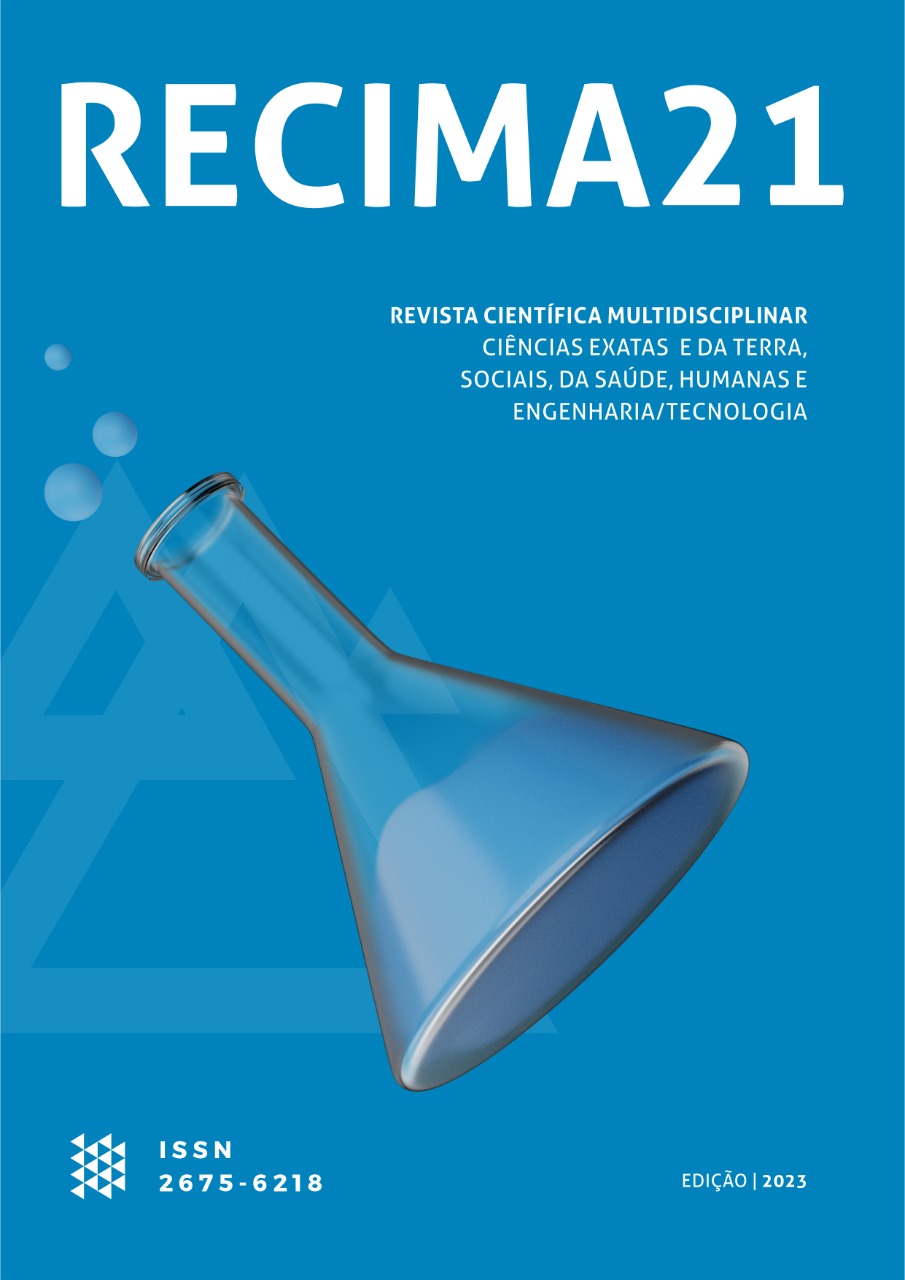FATORES PSICOSSOCIAIS ASSOCIADOS AO SUICÍDIO NO BRASIL: 2010, 2015 E 2020
DOI:
https://doi.org/10.47820/recima21.v4i5.3125Palavras-chave:
Autodestruição, Causas Multivariadas , CulturaResumo
O suicídio é um problema de saúde pública que possui causas multivariáveis, desde questões psicológicas até fatores sociais. Diante disso, o artigo objetivou examinar e comparar as taxas de suicídio de um grupo referente a três anos (2010, 2015 e 2020), para que seja possível compreender os padrões e as variações entre os anos. Para isso, foram utilizados os dados do DATASUS, na categoria do CID-10, das lesões autoprovocadas intencionalmente, em conjunto com as variáveis: sexo, local de ocorrência e raça/cor. A técnica empregada foi a de variância multivariada (MANOVA), a fim de destacar e aferir as estatísticas descritivas respectivas a cada ano. Os resultados demonstraram que a variável sexo e a variável local de ocorrência não apresentaram igualdade nas médias entre os grupos dos anos analisados, onde apenas a variável cor/raça apresentou consideravelmente essa igualdade no vetor média. Além disso, a prevalência do suicídio no sexo masculino e em domicílio apresentaram padrões nos três anos, justificado por questões culturais. Portanto, conclui-se que, o suicídio tem aspectos diferentes pela variação da interpretação que o sujeito dá ao suicídio dependendo do contexto e época vigente, sendo necessário o desenvolvimento de medidas preventivas.
Downloads
Referências
ABASSE, Maria Leonor Ferreira et al. Análise epidemiológica da morbimortalidade por suicídio entre adolescentes em Minas Gerais, Brasil. Ciência & Saúde Coletiva, v. 14, p. 407-416, 2009 Disponível em: https://www.scielosp.org/article/ssm/content/raw/?resource_ssm_path=/media/assets/csc/v14n2/a10v14n2.pdf. Acesso em: 11 de mar. de 2023.
BAÉRE, Felipe de; ZANELLO, Valeska. O gênero no comportamento suicida: Uma leitura epidemiológica dos dados do Distrito Federal. 2018. DOI: http://dx.doi.org/10.22491/1678-4669.20170008
CAMPOS, Ioneide de Oliveira; RAMALHO, Walter Massa; ZANELLO, Valeska. Saúde mental e gênero: O perfil sociodemográfico de pacientes em um centro de atenção psicossocial. 2017. Disponível em: https://repositorio.unb.br/handle/10482/35362. Acesso em: 11 de mar. de 2023.
CAMPILLO SERRANO, Carlos; FAJARDO DOLCI, Germán. Prevención del suicidio y la conducta suicida. Gaceta médica de México, v. 157, n. 5, p. 564-569, 2021. DOI: https://doi.org/10.24875/GMM.M21000611
DA SILVA, Daniel Augusto; MARCOLAN, João Fernando. Tendência da taxa de mortalidade por suicídio no Brasil. Revista Baiana de Enfermagem, v. 36, 2022. Disponível em: https://doi.org/10.18471/rbe.v36.45174. Acesso em: 11 de mar. de 2023.
FAROOQ, Saeed et al. Suicide, self-harm and suicidal ideation during COVID-19: A systematic review. Psychiatry research, v. 306, p. 114228, 2021. DOI: https://doi.org/10.1016/j.psychres.2021.114228
FRIENDLY, Michael; SIGAL, Matthew. Recent advances in visualizing multivariate linear models. Revista Colombiana de Estadística, v. 37, n. 2, p. 261-283, 2014. DOI: https://doi.org/10.1198/106186007X208407
LOVISI, Giovanni Marcos et al. Análise epidemiológica do suicídio no Brasil entre 1980 e 2006. Brazilian Journal of Psychiatry, v. 31, p. S86-S93, 2009. DOI: https://doi.org/10.1590/S1516-44462009000600007
NASCIMENTO, Alice Barbosa; MAIA, Juliana Leal Freitas. Comportamento suicida na pandemia por COVID-19: Panorama geral. Research, Society and Development, v. 10, n. 5, p. e59410515923-e59410515923, 2021. Disponível em: file:///C:/Users/gabri/Downloads/15923-Article-197966-1-10-20210515.pdf. Acesso em: 15 de mar. de 2023.
O'CONNELL, Katherine L. et al. Association between race and socioeconomic factors and suicide-related 911 call rate. Social Science & Medicine, v. 306, p. 115106, 2022. DOI: https://doi.org/10.1016/j.socscimed.2022.115106
Organização Mundial da Saúde. Um relatório sobre Suicide Worldwide in 2019.Genebra: OMS, 2021. Disponível em:: file:///C:/Users/gabri/Downloads/9789240026643-eng.pdf. Acesso em: 15 de mar. de 2023.
ROCHA, Daniel de Macêdo et al. Comportamento suicida durante a pandemia da COVID-19: aspectos clínicos e fatores associados. Acta Paulista de Enfermagem, v. 35, 2022. DOI: https://doi.org/10.37689/acta-ape/2022AO02717
SANTANA, Paula. Introdução à geografia da saúde: território, saúde e bem-estar. Imprensa da Universidade de Coimbra/Coimbra University Press, 2014.
SCHUCK, Fernanda Wartchow et al. A influência da pandemia de COVID-19 no risco de suicídio. Brazilian Journal of health Review, v. 3, n. 5, p. 13778-13789, 2020. Disponível em:: https://ojs.brazilianjournals.com.br/ojs/index.php/BJHR/article/view/17583. Acesso em: 15 de mar. de 2023.
STABILE, A. Jair Bolsonaro propôs acabar com reserva indígena Yanomami quando era deputado. G1, 27 de janeiro de 2023. Disponível em: https://g1.globo.com/rr/roraima/noticia/2023/01/27/jair-bolsonaro-propos-acabar-com-reserva-indigena-yanomami-quando-era-deputado-leia-integra.ghtml. Acesso em: 16 de mar. de 2023.
TURECKI, Gustavo et al. Suicide and suicide risk. Nature reviews Disease primers, v. 5, n. 1, p. 74, 2019. DOI: https://doi.org/10.1038/s41572-019-0121-0
WICKHAM, Hadley et al. Welcome to the Tidyverse. Journal of open source software, v. 4, n. 43, p. 1686, 2019. DOI: https://doi.org/10.21105/joss.01686
Downloads
Publicado
Edição
Seção
Categorias
Licença
Copyright (c) 2023 RECIMA21 - Revista Científica Multidisciplinar - ISSN 2675-6218

Este trabalho está licenciado sob uma licença Creative Commons Attribution 4.0 International License.
Os direitos autorais dos artigos/resenhas/TCCs publicados pertecem à revista RECIMA21, e seguem o padrão Creative Commons (CC BY 4.0), permitindo a cópia ou reprodução, desde que cite a fonte e respeite os direitos dos autores e contenham menção aos mesmos nos créditos. Toda e qualquer obra publicada na revista, seu conteúdo é de responsabilidade dos autores, cabendo a RECIMA21 apenas ser o veículo de divulgação, seguindo os padrões nacionais e internacionais de publicação.













